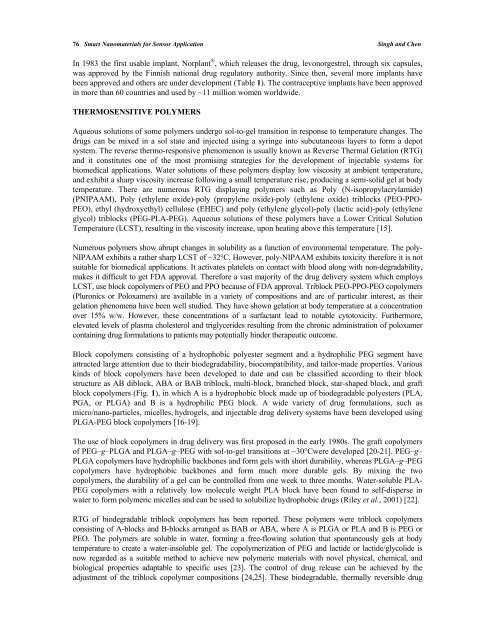Download - Bentham Science
Download - Bentham Science
Download - Bentham Science
Create successful ePaper yourself
Turn your PDF publications into a flip-book with our unique Google optimized e-Paper software.
76 Smart Nanomaterials for Sensor Application Singh and Chen<br />
In 1983 the first usable implant, Norplant ® , which releases the drug, levonorgestrel, through six capsules,<br />
was approved by the Finnish national drug regulatory authority. Since then, several more implants have<br />
been approved and others are under development (Table 1). The contraceptive implants have been approved<br />
in more than 60 countries and used by ~11 million women worldwide.<br />
THERMOSENSITIVE POLYMERS<br />
Aqueous solutions of some polymers undergo sol-to-gel transition in response to temperature changes. The<br />
drugs can be mixed in a sol state and injected using a syringe into subcutaneous layers to form a depot<br />
system. The reverse thermo-responsive phenomenon is usually known as Reverse Thermal Gelation (RTG)<br />
and it constitutes one of the most promising strategies for the development of injectable systems for<br />
biomedical applications. Water solutions of these polymers display low viscosity at ambient temperature,<br />
and exhibit a sharp viscosity increase following a small temperature rise, producing a semi-solid gel at body<br />
temperature. There are numerous RTG displaying polymers such as Poly (N-isopropylacrylamide)<br />
(PNIPAAM), Poly (ethylene oxide)-poly (propylene oxide)-poly (ethylene oxide) triblocks (PEO-PPO-<br />
PEO), ethyl (hydroxyethyl) cellulose (EHEC) and poly (ethylene glycol)-poly (lactic acid)-poly (ethylene<br />
glycol) triblocks (PEG-PLA-PEG). Aqueous solutions of these polymers have a Lower Critical Solution<br />
Temperature (LCST), resulting in the viscosity increase, upon heating above this temperature [15].<br />
Numerous polymers show abrupt changes in solubility as a function of environmental temperature. The poly-<br />
NIPAAM exhibits a rather sharp LCST of ~32°C. However, poly-NIPAAM exhibits toxicity therefore it is not<br />
suitable for biomedical applications. It activates platelets on contact with blood along with non-degradability,<br />
makes it difficult to get FDA approval. Therefore a vast majority of the drug delivery system which employs<br />
LCST, use block copolymers of PEO and PPO because of FDA approval. Triblock PEO-PPO-PEO copolymers<br />
(Pluronics or Poloxamers) are available in a variety of compositions and are of particular interest, as their<br />
gelation phenomena have been well studied. They have shown gelation at body temperature at a concentration<br />
over 15% w/w. However, these concentrations of a surfactant lead to notable cytotoxicity. Furthermore,<br />
elevated levels of plasma cholesterol and triglycerides resulting from the chronic administration of poloxamer<br />
containing drug formulations to patients may potentially hinder therapeutic outcome.<br />
Block copolymers consisting of a hydrophobic polyester segment and a hydrophilic PEG segment have<br />
attracted large attention due to their biodegradability, biocompatibility, and tailor-made properties. Various<br />
kinds of block copolymers have been developed to date and can be classified according to their block<br />
structure as AB diblock, ABA or BAB triblock, multi-block, branched block, star-shaped block, and graft<br />
block copolymers (Fig. 1), in which A is a hydrophobic block made up of biodegradable polyesters (PLA,<br />
PGA, or PLGA) and B is a hydrophilic PEG block. A wide variety of drug formulations, such as<br />
micro/nano-particles, micelles, hydrogels, and injectable drug delivery systems have been developed using<br />
PLGA-PEG block copolymers [16-19].<br />
The use of block copolymers in drug delivery was first proposed in the early 1980s. The graft copolymers<br />
of PEG–g–PLGA and PLGA–g–PEG with sol-to-gel transitions at ~30°Cwere developed [20-21]. PEG–g–<br />
PLGA copolymers have hydrophilic backbones and form gels with short durability, whereas PLGA–g–PEG<br />
copolymers have hydrophobic backbones and form much more durable gels. By mixing the two<br />
copolymers, the durability of a gel can be controlled from one week to three months. Water-soluble PLA-<br />
PEG copolymers with a relatively low molecule weight PLA block have been found to self-disperse in<br />
water to form polymeric micelles and can be used to solubilize hydrophobic drugs (Riley et al., 2001) [22].<br />
RTG of biodegradable triblock copolymers has been reported. These polymers were triblock copolymers<br />
consisting of A-blocks and B-blocks arranged as BAB or ABA, where A is PLGA or PLA and B is PEG or<br />
PEO. The polymers are soluble in water, forming a free-flowing solution that spontaneously gels at body<br />
temperature to create a water-insoluble gel. The copolymerization of PEG and lactide or lactide/glycolide is<br />
now regarded as a suitable method to achieve new polymeric materials with novel physical, chemical, and<br />
biological properties adaptable to specific uses [23]. The control of drug release can be achieved by the<br />
adjustment of the triblock copolymer compositions [24,25]. These biodegradable, thermally reversible drug

















